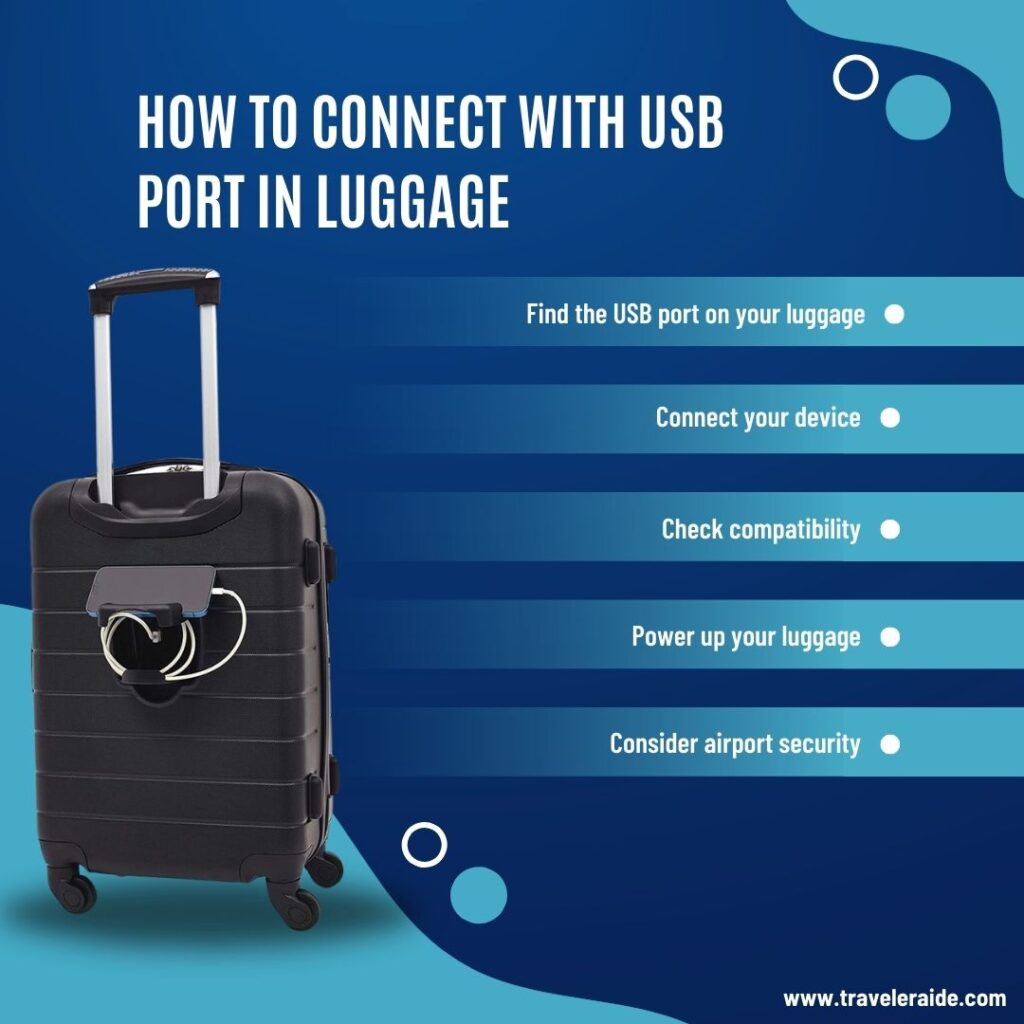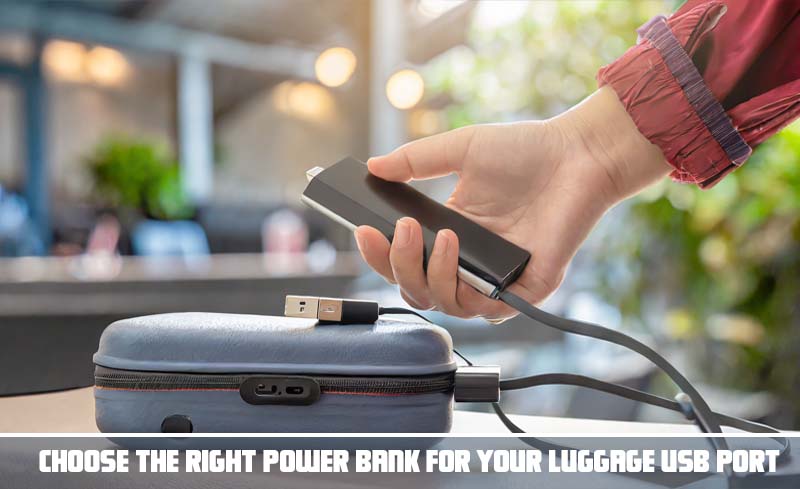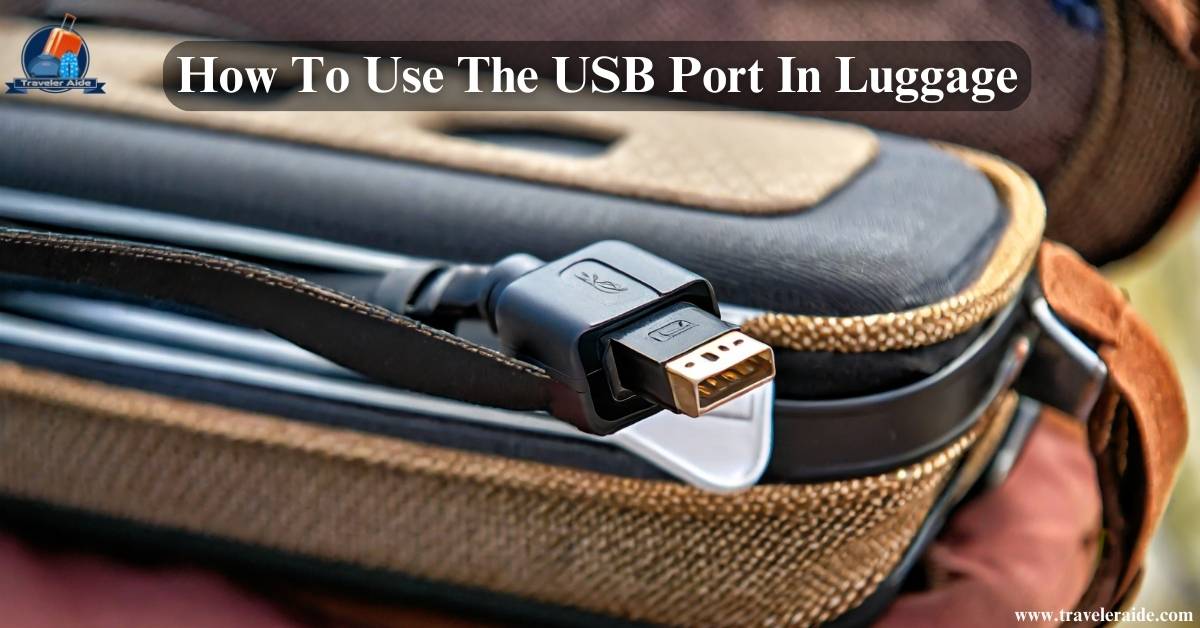As a seasoned traveler, I’ve been to everything from sun-drenched to busy cities, always seeking new experiences. I’ve learned to appreciate any features that make life on the road easier. One of my latest discoveries is luggage with built-in USB charging ports.
At first, I was skeptical about how useful an integrated USB port could really be. I also had concerns about data security. But I’m convinced after using smart luggage with USB charging on several recent trips.
The USB port makes it incredibly convenient to keep my devices charged while in transit. I don’t need to hunt for an available power outlet.
Here, I’ll share how to make the most of the USB port in my luggage and some tips to ensure a safe, hassle-free experience. So let’s go to start.
How to Connect with USB Port In Luggage
As an experienced traveler, I always appreciate extra conveniences. They make life on the road easier. One of my favorite recent additions is the USB port built into many new pieces of luggage.
It allows you to charge your devices on the go. You won’t have to hunt for an outlet at the airport or pull out a portable charger. Here’s how I use the USB port in my luggage:

1. Find the USB port on your luggage
The USB port is typically on the bag’s exterior, like a zipper pull or luggage tag. On backpacks, it may be built into an external pocket. Look for a small rectangular port, usually labeled “USB.”
2. Connect your device
Plug one end of a USB charging cable into the port on your luggage. Plug the other end into your phone, tablet, wireless headphones, or other device. Some luggage has a built-in retractable USB cable. It connects directly to the power bank inside.
3. Check compatibility
Most standard phone charging cables will work with a luggage USB port. Double-check that the voltage and amperage meet your specific device’s requirements. I carry a portable charger in my bag as a backup. The USB port might need more power for all my electronics.
4. Power up your luggage
Your luggage must contain a portable charger or power bank that allows the USB port to function. My luggage came with a power bank, but you can purchase one separately. Look for a high-capacity power bank, at least 10,000 mAh, to charge many devices on the go.
5. Consider airport security
The USB port itself won’t trigger any issues with airport security. However, the internal power bank needs to follow size and capacity restrictions for lithium batteries. If your power bank meets these guidelines, you can feel comfortable using the USB port to charge in the airport and during your flight.
Here are a few tips: Don’t overload the USB port by charging too many high-drain devices simultaneously. Stick to two or three at a time.
Be mindful of any airline restrictions on power banks for checked luggage. And take standard precautions – don’t leave expensive tech gear unattended while charging.
Using the USB port in my luggage has made travel much more convenient. With the right power bank, I never worry about my devices dying on a long trip again!
Choose the Right Power Bank for Your Luggage USB Port
Here are some ways to make the most of the USB port on your luggage:

1. Find a Power Bank That Fits in the Luggage Pocket
Many luggage brands have a dedicated zippered pocket for a power bank. Make sure any power bank you buy will fit comfortably in that pocket. A slim, lightweight power bank is ideal for this.
2. Consider a Power Bank With Multiple Ports
A power bank with USB-C and standard USB ports lets you charge all your devices. Some also have built-in cables, so you don’t have to pack additional charging cables. I found a power bank with at least two standard USB ports, and one USB-C port covers all my needs.
3. Test the Power Bank Before Your Trip
Once you purchase a power bank, test it before your trip to ensure it charges your devices correctly. Also, make sure it fits in your luggage pocket. Check that any built-in cables or ports are working. See how many total charges you can get from a single power bank charge. That way, you can avoid issues once you’re on the move!
4. Choose a Power Bank That Meets Airline Requirements
Look for a power bank that adheres to airline regulations for size and capacity. Most major airlines allow power banks up to 27,000 mAh in capacity if they’re in your carry-on baggage. I like to use a 10,000 mAh or 20,000 mAh power bank. It provides plenty of charge for my phone, tablet, headphones, and other gadgets.
You can keep your electronic gear juiced up no matter where your travels take you. Just use the USB port in your luggage and a good power bank.
Are there any airline restrictions on using the USB port in luggage?
If your luggage has a built-in USB port, you can conveniently charge your devices without an outlet. But, there are some essential things to remember when using the USB port during travel.

1. Airline restrictions
Most airlines allow you to use the USB port in your carry-on or checked luggage. However, some airlines restrict smart luggage with non-removable lithium batteries. For example, American Airlines no longer accepts smart bags with non-removable batteries as checked or carry-on luggage. To avoid issues, check with your airline beforehand. Consider removable battery options if needed.
2. Power bank requirements
You’ll need a portable charger or power bank to use the USB port. Look for one with at least 10,000 mAh, giving you 2-3 total phone charges. Ensure it’s within the size and capacity limits for carry-on and checked luggage. I recommend using a reputable brand to ensure safety, quality, and compatibility.
3. Airport security
When going through airport security, you may be asked to temporarily remove your portable charger from your carry-on bag. This way, it can be screened separately. It should be allowed as long as it meets the standard requirements for mobile electronic devices.
However, ensure that any devices with lithium batteries are turned off for checked bags before packing. It helps avoid issues.
4. Safety Tips
To protect your devices and personal data, only use the USB port to charge devices you own. Avoid connecting unfamiliar USB drives. While the odds of hacking are low, it’s best to take standard precautions. Like any electronics, avoid overheating the USB port or power bank. Make sure to leave charging devices unattended for long periods.
By following these tips, you can feel confident using the USB port in your luggage. You can stay charged wherever your travels take you!
How to Use Luggage USB Port Safely at the Airport
Here are my tips for using your luggage USB port safely and conveniently at the airport:
1. Find the right portable charger
You’ll want a portable charger, also known as a power bank. It should have enough capacity to charge your devices multiple times. Look for a charger with at least 10,000 mAh, which should handle most smartphones and tablets. Make sure it can charge via USB so it’s compatible with your luggage.
2. Use your own charging cable
Bring your own USB charging cable to plug into the port on your luggage. Public charging cables at airports can be unsafe. Hackers have been known to load malware onto them to access data and passwords from electronic devices. Using your cable helps prevent data theft.
3. Find an outlet or portable charger
Instead of using public USB charging stations, which may be vulnerable to hackers, I recommend using an AC power outlet. Plug your luggage USB port directly into it. Alternatively, you can use your portable charger. It provides the safest charging option while traveling.
4. Know the rules
Be aware of any regulations regarding using USB ports and portable chargers when going through airport security. Also, be mindful of regulations during your flight. Most airports and airlines allow portable chargers and USB cables in carry-on luggage.
But, larger power banks may need to be removed when going through security. Check with authorities to ensure you follow proper guidelines.
By following these tips, you can feel confident using the USB port on your luggage. It will keep your devices powered up during your travels. Plus, you’ll stay safe from data theft.
Troubleshoot Common Issues With Luggage USB Ports
As an experienced traveler, I’ve relied on my luggage’s built-in USB port more times than I can count. It’s been a lifesaver when my phone battery runs low, and I need to charge it on the go. But USB ports can be finicky, so here are some tips to troubleshoot common issues.
The first thing to check is if the USB port is visibly damaged or dirty. Clean out any debris with a toothpick, then try reconnecting your cable. If that doesn’t work, the issue could be with the internal wiring or connections in the luggage. Unfortunately, this may require service from the manufacturer if it is still under warranty.
As a last resort, you can use a different cable or charger to rule out a problem with your own devices.
For the USB port to function correctly, it needs adequate power. The built-in battery or power bank may need recharging if it’s not charging your devices. I always carry a portable charger as a backup power source if the luggage USB port isn’t working.
When using the USB port in flight, some airlines may restrict charging electronic devices during takeoff or landing.
Following crew instructions, the USB port should be perfectly safe for your devices. It won’t interfere with the plane’s systems. I don’t recommend charging unknown or untrusted devices via the luggage USB port. It’s for the most significant security.
Troubleshoot common issues. Keep a portable charger on hand. Follow regulations for in-flight electronic device use. This way, you’ll get the most out of your luggage’s USB port and enjoy the convenience of charging on the go.
FAQs
How Do USB Port Bags Work?
USB port bags work by having a built-in power bank that stores energy. You can connect your device to the USB port, and the power bank charges your device while you’re on the move.
Can You Fly with a USB Charger Suitcase?
Yes, you can generally fly with a USB charger suitcase. Before you fly, checking the airline’s rules for using electronics and USB chargers is smart. Make sure you also know the guidelines for lithium-ion batteries.
Why Does My Bag Have a USB Port?
Your bag has a USB port to provide a convenient and portable way to charge your electronic devices. It ensures you stay connected and powered up while on the go.
What Is a Smart Suitcase?
An intelligent suitcase has extra features like GPS tracking and a built-in scale. You can remotely lock and unlock it, too. It usually has a USB charging port, too. These features enhance convenience and security for travelers.
Conclusion
After years of experience traveling with this handy feature, the USB port in luggage is a total game changer. No more scrambling to find an outlet at the airport or paying high prices for portable chargers from airport vendors.
Packed in your carry-on, you’ll have juice for all your devices whenever and wherever you need it. The next time you’re shopping for new luggage, consider a model with a built-in USB port – your future travel self will thank you!
Using the USB port in luggage is convenient and safe and helps ensure you make the most of your adventures. Let me know if you have any other questions!

Hey, I’m Dorothy E. Turner! I’ve spent years exploring the world and diving deep into the travel scene. Along the way, I’ve developed a real knack for understanding what makes a great travel backpack. I’m passionate about sharing my expertise to help fellow travelers find the perfect backpack for their adventures.



2 thoughts on “How To Use The USB Port In Luggage- A Comprehensive Guide”